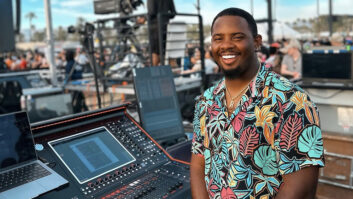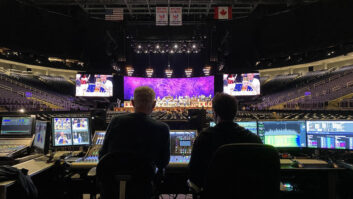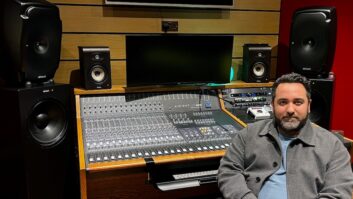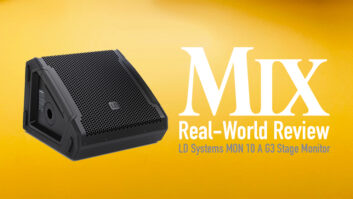
The theory goes like this: If people buy fewer CDs, then recordcompany budgets shrink and recording studios make less money. Thismeans that studios don’t buy as much new equipment, so the technologycompanies that build those wonderful audio toys experience a drop inbusiness. Well, maybe. There is an equally compelling argument thatindependent CD releases and the democratization of recordingcapabilities through studio-in-a-box software and less-expensiveequipment mean better sales to a larger mass audience. There may besmaller budgets for major releases, but there is just as much music— and audio — being produced.
Pro audio is no longer a cottage industry that’s immune to economicfactors of the global market. The growth in affordable digitaltechnologies means that professional audio is now part of a largermedia system. And when political and economic uncertainty strike, ourlittle industry feels the ripples.
So what’s really going on with pro audio technology andmanufacturing companies? Between the advent of digital processing,computer-based production, Internet marketing and a changing recordingindustry, what must pro audio manufacturers do to stay competitive andrelevant? Are only big-ticket hardware companies affected? Are softwarecompanies being decimated by piracy? Have we reached the crossroadswhere existing business models have permanently changed?
HOW’S BUSINESS?
The first issue to be addressed is overall sales trends. Are marketsup, down or flat? Computers play a major role in contemporary audioproduction, so companies with an emphasis on computer-based productsseem to be faring well. M-Audio designs and manufactures audio and MIDIinterfaces, keyboards, speakers and microphones. The company alsodistributes Ableton, Propellerhead and Arkaos software, so it hasstaked its claim firmly in the computer audio and music arena.According to M-Audio marketing director Adam Castillo,“Computer-based music production is the healthiest segment of ourindustry, and that’s where we see all of the success stories.” Asa result, according to year-end financials, M-Audio sales were up by74% in 2002.
Even companies traditionally associated with hardware electronicsfind that having a hand in the computer arena helps even out theproduct mix. Universal Audio president Matt Ward says, “For asmall company, we are very diverse. We have analog hardware andsoftware plug-in systems for virtually every computer-based audiosystem out there. Universal Audio sells to three overlapping markets:We sell hand-built analog mic preamps and compressors primarily tohigh-end recording users; Mackie sells our UAD-1 DSP card with PoweredPlug-Ins to the native workstation/desktop music market; and we sellTDM plug-ins to users of Digidesign’s Pro Tools Mix 24 and Pro Tools|HDsystems.” According to Ward, sales are up and the company islooking to double the amount of space it now occupies.
Another company that is strong in computer-based audio products isTC Works, a division of TC Electronic. According to Ralf Schluenzen,CEO of TC Works, the company’s Powercore product has fueled thecompany’s market success: “Our key product is Powercore: doingapproximately 60 to 70 percent of our turnover and still rising. Wewere quite fortunate with Powercore, bringing such a relevant productto market that was accepted much faster than we anticipated.
“It is always a concern to have such strong product dominatingsales so much,” Schluenzen admits. “However, in this case,we are talking about a platform; i.e., the products are the softwareproducts utilizing it — like Assimilator, the included plug-insand so on. Obviously, there will be more. Also, in May we are launchinga FireWire version of Powercore, expanding the platform. In otherwords, a car manufacturer makes the most money selling cars, so I wouldlike to compare Powercore more to a category than a product.”
Having a hardware component involved is significant and seems to bea common theme with many of the companies interviewed. Schluenzen notesthat, “the software products alone would not be able to fund thisbusiness.” One of the most successful companies at combiningcomputer-based hardware and software into systems solutions isDigidesign. Not surprisingly, Digidesign has been able to maintainbusiness growth. General manager Dave Lebolt says, “Our businessexperienced healthy revenue growth in 2002, and our fundamentals haveremained strong during the worldwide economic downturn. Key driversincluded new products like Pro Tools|HD, Digi 002 and the Mbox.”These products cater to the high-end, mid-segment and lower-end users,offering diversification to different markets and providing Digidesignwith more financial stability.
Yamaha is the world’s largest manufacturer of audio products andmusical instruments. According to Larry Italia, general manager of theCommercial Audio Systems division of the Yamaha Corporation of America,“Sales have been up significantly for us in the commercial audioarea; by ‘commercial audio,’ we mean all markets except MI.I think our business is unusual in this regard and see most of themajor competitors trending downward.”
INDUSTRY FEAR FACTORS
This last comment — “We’re okay, but our competitors arehaving problems” — was echoed by several companies. Wewanted to know what factors are seen as most responsible for this.
The obvious place to start is the recent slump in the recordbusiness. Whatever the reasons given — song-swapping services,piracy from home CD burning, the high price of CDs, etc. — it’sclear that less revenue in the pipeline that eventually leads back toartists and studios can affect equipment purchases. Several executivessaw this as a potential problem. Lebolt of Digidesign says,“Declining sales for the majors can hurt our overall sales as[tighter] recording budgets affect both larger recording facilities andartists’ personal studios. Less money in the industry hurtseveryone.”
Yamaha’s Italia points out that the effect goes beyond the recordingstudio and into the concert hall. “The drop in record sales isobviously a negative,” he says. “It affects not only ourrecording products business, but touring sound, as well.”
“The drop in record sales is a dangerous trend,” addsSchluenzen. “The major labels have their own share of blame inthis situation, as they were too slow to react to the dramatic marketchanges. At the same time, we’re in a situation where a lot of thingsare changing — all at the same time and extremely fast due to theWeb and technological advances in general.”
ON THE PLUS SIDE
The counter-trend, then, is the growing power that technology hasput within reach of independent musicians with modest resources. Thisapplies to both the supply side (the recording process itself) and tothe distribution side, with the growth of alternate music-distributionavenues.
Several independent factors are at work here:
- The recording studio focus has shifted from large facilities tohome/project studio production;
- the use of computer software for audio processing has increased;and
- independent music-distribution channels have grown.
Nearly everyone sees a business benefit in these developments.
“While the record industry is in a state of flux,”Lebolt says, “there has been an explosion in terms of smallerindie labels, artist self-promotion using the Net and grassrootsinteraction. Our gear has been part of the trend toward democratizationand ‘bedroom creation’ that makes this possible, so ourbusiness is generally positively affected.”
M-Audio’s Castillo likewise sees benefits: “The increase inthe power and capabilities of CPUs and software have enabled a‘democratization’ of music production. The‘Everyman’ can now accomplish what amounts to commerciallyviable music production with a relatively modest investment. Today,we’re seeing more and more ‘non-musicians’ getting intocontent creation. Thanks to programs like Reason, coupled with MP3distribution, the barrier of entry into this arena has been greatlylowered.”
Although the benefits of software-based production are clear, a noteof caution was given by several companies: As products become moresoftware-centric, piracy becomes more of an economic issue formanufacturers, to the point that most build it into their businessplan.
“Native processing sales are quite disappointing, piracy beingthe main reason,” admits Schluenzen. “In my opinion, thisis only a symptom of the general lack of a truly working business modelfor intellectual property in the increasingly networked digitalworld.” For more on piracy, see the sidebar on page 114.
WHERE TO SELL?
Most manufacturers depend on a network of resellers to bring theirproducts to the masses. These distribution channels for pro audio andmusic gear have also gone through a lot of recent changes. For manyyears, it was the pro audio specialty shop that afforded the onlyoutlet for high-end audio components and systems. As more and morecapabilities became available at lower price points, the line betweenpro audio and MI stores began to blur. Boutique pro audio dealers arestill an attractive way to go for many professionals looking to outfita studio. They provide a systems approach to building integratedpackages, have knowledgeable sales staffs and provide personalizedservice.
But for many buyers, the large retail chains such as Guitar Center,Sam Ash and others provide a convenient way to find all but the mostesoteric and expensive gear. Of course, business fundamentals stillcount in the age of superstores, as proven by the October 2002liquidation of the Mars Music chain. Mars once boasted as many as 50retail outlets, but its demise left a number of manufacturers withuncollected receivables and a lot of orphaned customers.
A company that took a different approach to retail is proving thatpro audio and music gear can be sold without depending on a“brick-and-mortar” location. Sweetwater Sound Inc. hasgrown dramatically since its inception in 1979 as a recording studio inFort Wayne, Ind., to its present status as one of the largest pro audioand music distributors.
Sweetwater has gone far beyond the old “mail order”mentality to provide knowledgeable service and support from a staff whoknows the equipment and the business. The company has three in-housestudios so that they can keep a finger on the pulse of how the gearthey sell is used in the real world. According to Jeff Radke, VP ofsales at Sweetwater, this approach has paid off: “We’ve workedvery hard and have been fortunate to experience nice, consistentgrowth, even in 2002.”
Radke sees the trend toward project studio production as just partof the overall puzzle and believes that there will always be a placefor larger studio facilities in the overall production chain. “Weoperate a studio facility here with three rooms so it’s a trend we’revery aware of,” he says. “However, this isn’t necessarily anew trend at all…it all really started in a big way back in theearly ’80s. The fact remains that while wonderful recordings can bemade at home, unless you have the right room, the expertise and thecomplete complement of gear, it’s very difficult to get the samequality of sound you’ll get recording in a serious studio. One trendwe’ve seen is projects being largely tracked at home and then refined,polished and mastered at a larger facility.”
WHAT WOULD YOU BID?
The successful use of the Internet, telephone and mail-order catalogsales is not exclusive to Sweetwater, of course. Guitar Center ownsMusician’s Friend, a popular Web destination for audio buyers; Sam Ashhas a robust e-commerce site; sites such as Zzounds.com and severalothers prove that there are plenty of shopping options on the Web.Another reseller category is represented by auction sites such asDigibid.com and the mother of them all, eBay.
eBay has grown to be one of the few enduring success stories to comeout of the dotcom boom-bust era of the late ’90s. Although knownoriginally for auction-style trading, eBay also offers trading in afixed-price format. Many manufacturers and importers find it to be anefficient way to find a home for inventory close-outs and specials.
According to Giles Cassels, the general manager for musicinstruments, “eBay is the number one online marketplace formusical instruments, with over $340 million in musical instrument salesin 2002. The category is a first-destination marketplace for a widevariety of musicians, studio professionals and DJs, with a strongdemographic of music professionals and advanced amateurs. eBay offerseverything from the hottest new products from the most respected brandsto the hard-to-find vintage components that are the holy grail for theserious collector.”
As a distribution channel, eBay has proven wildly successful, withresults that would be considered astounding for any pro audio or musicoutlet. Cassels says, “Simply put, business is phenomenal. Themusical instruments category on eBay grew by 39 percent last year in anindustry of fairly low growth. In the pro audio category, our 2002revenues grew by 98 percent over 2001.
“Our musical instruments category is so strong right now thatan item successfully sells every 11 seconds,” he continues.“A pro audio component sells every 1.5 minutes; that’s over350,000 items in the course of a year! We also have a very loyal buyerbase, with the average buyer purchasing approximately 12 items withinthe category over the course of a year.”
It seems Internet distribution is a force that will continue toexert an influence on pro audio sales and close the feedback loopbetween manufacturers and consumers. According to Cassels, eBayacknowledges the difference between the musical instrument and proaudio categories and will be taking steps to recognize this on thesite: “Within the musical instruments category, we are developinga discrete, new marketplace portal exclusively for pro audio. Thisportal will include all of the pro audio inventory available on thesite, special merchandising and promotions, product reviews andcomparisons, and ‘how-to-buy’ content and FAQs. This portalis scheduled to launch toward the end of the second quarter.”
Of course, not all manufacturers see eBay as a legitimate means todistribute their products, because it could interfere with their othersales channels. Ward of Universal Audio says, “We don’t allow ourdealers to sell on eBay, and we’ve been cracking down on people who useour copyrighted text and pictures for eBay auctions. Given that werequire our dealers to stock our gear and encourage them to maintaindemo stock for customers, we can’t have them competing with 15 yearolds running a pro audio shop from mom’s computer.”
KEYS TO FUTURE SUCCESS
Finally, we asked about the outlook for the future of the pro audioequipment industry and, in particular, what these audio executivesbelieve they and their peers must do to maintain the health of theircompanies. Everyone recognizes that we have come a very long way inbringing superior quality and functionality within reach of the masses.This is a trend that is bound to continue. Ward says, “Companiesneed to take a long hard look at the value they provide. When I startedin this business, the difference in the quality of a final recordingproduced by a demo studio and a professional studio was huge. Today,people are recording great-sounding stuff on less than $5k worth ofgear. To be successful in this environment, companies must honestlyevaluate how their products improve the quality of their customers’final recordings and to be certain they are worth the money.”
This sentiment was echoed by Cassels of eBay: “There aretrends that are very specific to the industry that cannot be ignored.One trend that will continue to have a profound impact is thecontinuation of the ‘digital revolution,’ which is placingwhat used to be very specialized, complicated and expensive toolsdirectly in the hands of individual consumers.”
Another key theme is the continued expansion of software-centricapproaches to audio processing. Castillo of M-Audio notes,“Computers are going to increasingly become the center of allaudio production. Most importantly, in the next five years, we arelikely to see the demise of many ‘dinosaur’ companies thatcontinue to only sell traditional hardware: keyboards, recorders,etc.”
Finally, Schluenzen of TC Works points out that it is not enough tojust build great products; manufacturers should consider how to educateand develop the next generation of customers. “We need to alltake action as an industry,” he says, “and make sure wesupport the creation of a new generation of users: a new market to sellto in the future. This involves a lot of work with other partiesoutside of our direct neighborhood, ranging from computer manufacturersto schools and universities, as well as the record industry.”
The conclusion? Build better professional audio gear, of course, butat the same time, develop more and better customers. Make the processof creating music and audio so ubiquitous that we can all share in thiswonderful and most human of activities.
Visit Ron Franklin atwww.atiramedia.comandwww.ronfranklin.net.
The Price of Piracy

One of the scourges of the computer-based studio economy is softwarepiracy. If software companies can’t profit from their investment, thenusers will be left without new features, upgrades and proper support.We spoke to Bob Ellison, president of Syntrillium, manufacturer of CoolEdit Pro, about the issues involved.
Is software piracy an issue for Syntrillium? How important isit?
Software piracy is a fact of life. In some markets — likeCentral and South Americas, parts of Asia and Eastern Europe —Cool Edit is very widely used, despite the fact that almost no saleshave been recorded there. A Mexican systems integrator once told methat pirated copies of Cool Edit Pro are in use at virtually everyradio station in that country.
What steps does Syntrillium take to prevent software piracy? Howdo you feel about using software keys or dongles?
We make it difficult for unsophisticated computer users to pirateour software, but our anti-piracy measures are pretty mild. Our goal isto discourage the “casual pirate” — someone who mightpirate the software if it’s easy and convenient, but who otherwise iswilling to pay — but to not waste our efforts deterring dedicatedhackers.
Dongles represent what we think is wrong with extreme anti-piracymeasures. Everyone dislikes having to use dongles: They add to theprice of the software, they create sales fulfillment and technicalsupport problems, and they mean treating every user with a basic levelof distrust.
How does software piracy affect your company? Can you quantifythe financial impact?
We cannot quantify the financial impact, and we do not play thefalse game of some other software companies that like to count everypirated use as money out of their pockets. What hurts us most is whenthose who can afford the software choose instead to pirate it,and when the attitude that it’s okay to pirate software becomescommon.
One area in which piracy has a more calculable financial impact isin service and support. People call and e-mail Syntrillium every dayfor technical support for pirated versions of our software. We do whatwe can to efficiently weed out this deadweight cost, but it stillconsumes manpower and money that would otherwise be dedicated toserving paying customers.
How does it affect the audio industry as a whole?
Software piracy is probably more prevalent in the audio niche thanin most other software niches, because while musicians and recordingengineers invest deeply in their interests, their monies are commonlystrained, and software piracy represents a simple way to save money.Piracy takes a lot away from the revenues that audio softwaredevelopers could otherwise realize, and therefore inhibits newdevelopment and investment. So, fewer products are developed, and thesoftware consumers are hurt as much as the developers.
What would you say to musicians who feel software is tooexpensive?
I would ask, “What does that mean?” It’s a ridiculousstatement. Software development is hugely expensive, and softwarecompanies price their wares the same way companies in other industriesprice theirs: according to what they think the market will bear. Unlessa software product is free, someone will think it is overpriced. Likeany elective product, we say about our software: If you think it coststoo much, don’t buy it.
What can be done by the industry to bring software piracy undercontrol?
We must appeal to people’s sense of fair play. Musicians want to bepaid for their work and their intellectual property: music, lyrics andperformances. So do software companies. All of our products areavailable as free downloads for fully functional use and evaluation.Because of this, we are especially — grimly — amused whenpeople claim to have pirated our software only because they want to tryit before paying.
— Ran Franklin







